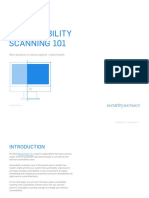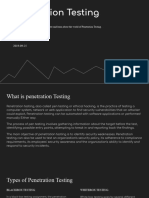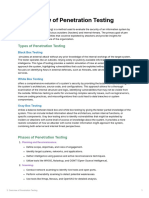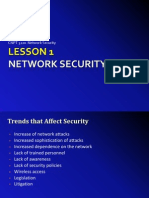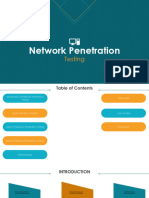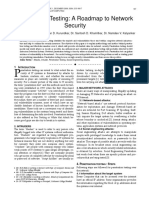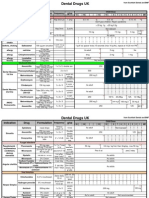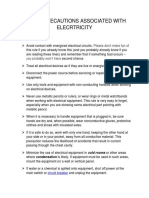IRM 1 WormInfection PDF
IRM 1 WormInfection PDF
Uploaded by
AravindhanCopyright:
Available Formats
IRM 1 WormInfection PDF
IRM 1 WormInfection PDF
Uploaded by
AravindhanOriginal Title
Copyright
Available Formats
Share this document
Did you find this document useful?
Is this content inappropriate?
Copyright:
Available Formats
IRM 1 WormInfection PDF
IRM 1 WormInfection PDF
Uploaded by
AravindhanCopyright:
Available Formats
Preparation
1 Identification
2 Containment
3
■ Define actors, for each entity, who will be Detect the infection The following actions should be performed and
involved into the crisis cell. These actors monitored by the crisis management cell:
Information coming from several sources should be
should be documented in a contact list kept gathered and analyzed:
permanently up to date. 1. Disconnect the infected area from the Internet.
■ Antivirus logs,
■ Make sure that analysis tools are up,
■ Intrusion Detection Systems, 2. Isolate the infected area. Disconnect it from
any network.
functional (Antivirus, IDS, logs analysers), not ■ Suspicious connection attempts on servers,
compromised, and up to date. ■ High amount of accounts locked, 3. If business-critical traffic cannot be
■ Suspicious network traffic, disconnected, allow it after ensuring that it
■ Make sure to have architecture map of your
■ Suspicious connection attempts in firewalls,
cannot be an infection vector or find validated
networks. circumventions techniques.
■ High increase of support calls,
■ Make sure that an up to date inventory of the ■ High load or system freeze, 4. Neutralize the propagation vectors. A
assets is available. ■ High volumes of e-mail sent
propagation vector can be anything from
network traffic to software flaw. Relevant
countermeasures have to be applied (patch,
■ Perform a continuous security watch and If one or several of these symptoms have been
traffic blocking, disable devices, etc.)
inform the people in charge of security about spotted, the actors defined in the “preparation” step
For example, the following techniques can be
the threat trends. will get in touch and if necessary, create a crisis
used:
cell.
- Patch deployment tools (WSUS),
■ Make sure that a Business Continuity Process
Identify the infection - Windows GPO,
has been defined and regularly tested for the - Firewall rules,
business-critical services. Analyze the symptoms to identify the worm, its - Operational procedures.
propagation vectors and countermeasures.
5. Repeat steps 2 to 4 on each sub-area of the
Leads can be found from : infected area until the worm stops spreading. If
■ CERT’s bulletins; possible, monitor the infection using analysis
tools (antivirus console, server logs, support
■ External support contacts (antivirus calls).
companies, etc.) ;
■ Security websites (Secunia, SecurityFocus The spreading of the worm must be monitored.
etc.)
Notify Chief Information Security Officer. Mobile devices
Contact your CERT if required.
Make sure that no laptop, PDA or mobile storage
Assess the perimeter of the infection can be used as a propagation vector by the worm.
If possible, block all their connections.
Define the boundaries of the infection (i.e.: global
infection, bounded to a subsidiary, etc.). Ask end-users to follow directives precisely.
If possible, identify the business impact of the
infection. At the end of this step, the infection should be
contained.
Remediation
4 Recovery
5 Incident Response Methodology
Verify all previous steps have been done correctly
Identify
and get a management approval before following
Identify tools and remediation methods. next steps.
The following resources should be considered:
- Vendor fixes (Microsoft, Oracle, etc.) 1. Reopen the network traffic that was used as a IRM #1
- Antivirus signature database propagation method by the worm.
- External support contacts Worm Infection Response
Guidelines to handle information system Worm infections
- Security websites 2. Reconnect sub-areas together ___________________________________________________
IRM Author: CERT SG / Vincent Ferran-Lacome
Define a disinfection process. The process has to 3. Reconnect the mobile laptops to the area IRM version: 1.3
be validated by an external structure, like your
E-Mail: cert.sg@socgen.com
CERT for example. 4. Reconnect the area to your local network Web: https://cert.societegenerale.com
Twitter: @CertSG
5. Reconnect the area to the Internet
Test
All of these steps shall be made in a step-by-step
Test the disinfection process and make sure that it
manner and a technical monitoring shall be Abstract
properly works without damaging any service. enforced by the crisis team.
This Incident Response Methodology is a cheat sheet dedicated
to incident handlers investigating a precise security issue.
Who should use IRM sheets?
Deploy Administrators
Deploy the disinfection tools. Several options can
Aftermath
6
Security Operation Center
CISOs and deputies
be used: Report CERTs (Computer Emergency Response Team)
- Windows WSUS A crisis report should be written and made Remember: If you face an incident, follow IRM, take notes
- GPO available to all of the actors of the crisis and do not panic. Contact your CERT immediately if
- Antivirus signature deployment management cell. needed.
- Manual disinfection
The following themes should be described: Incident handling steps
Warning: some worms can block some of the - Initial cause of the infection
remediation deployment methods. If so, a - Actions and timelines of every important
6 steps are defined to handle security Incidents
workaround has to be found. event Preparation: get ready to handle the incident
- What went right Identification: detect the incident
Remediation progress should be monitored by the - What went wrong Containment: limit the impact of the incident
crisis cell. Remediation: remove the threat
- Incident cost Recovery: recover to a normal stage
Aftermath: draw up and improve the process
Capitalize
Actions to improve the worm infection management IRM provides detailed information for each step.
processes should be defined to capitalize on this
experience.
This document is for public use
You might also like
- Hose Products and Tooling Guide 8th EditionDocument332 pagesHose Products and Tooling Guide 8th EditionKeron Trotz100% (4)
- Vulnerability Assessment and Penetration TestingDocument6 pagesVulnerability Assessment and Penetration Testingseventhsensegroup100% (1)
- Deception Solution Overview: Deceive. Detect. DefendDocument4 pagesDeception Solution Overview: Deceive. Detect. DefendJimmy Alfaro HernandezNo ratings yet
- Grade 8 Summative Test (Matter) NAME: - YEAR & SEC.: - DATE: - SCOREDocument3 pagesGrade 8 Summative Test (Matter) NAME: - YEAR & SEC.: - DATE: - SCOREmenchie ismaelNo ratings yet
- An Introduction To Language and Linguistics Additional Exercises - Chapter 1Document9 pagesAn Introduction To Language and Linguistics Additional Exercises - Chapter 1Muhammad AakashNo ratings yet
- Vulnerability Assessment and Penetration Testing PDFDocument6 pagesVulnerability Assessment and Penetration Testing PDFproftechitspecialistNo ratings yet
- Incident Response MethodologyDocument78 pagesIncident Response MethodologySeref DemirNo ratings yet
- Ransom PlaybookDocument5 pagesRansom Playbookahmethan3572No ratings yet
- Pentest BlueprintDocument1 pagePentest Blueprinttoanquoc.doanNo ratings yet
- IRM 5 MaliciousNetworkBehaviourDocument2 pagesIRM 5 MaliciousNetworkBehaviourtaekNo ratings yet
- SOC CyberthreatsDocument12 pagesSOC CyberthreatsPranav Haran HarichandranNo ratings yet
- Process Penetration TestingDocument3 pagesProcess Penetration TestingCyber Security HiveNo ratings yet
- Researching Network Attacks and Security Audit ToolsDocument4 pagesResearching Network Attacks and Security Audit ToolsAxelle CarcacheNo ratings yet
- 1 Malware (AV) - Unresolved Malware DetectedDocument9 pages1 Malware (AV) - Unresolved Malware DetectedsiemxpertNo ratings yet
- Vulnerability Scanning 101 White PaperDocument15 pagesVulnerability Scanning 101 White PaperJohn DoeNo ratings yet
- Ransomware Response ChecklistDocument7 pagesRansomware Response ChecklistMaokriz GrNo ratings yet
- TOPIC 1-Malware AnalysisDocument28 pagesTOPIC 1-Malware AnalysisNithiya SukunaranNo ratings yet
- Enterprise Log Graph TheoryDocument16 pagesEnterprise Log Graph TheoryJared MerloNo ratings yet
- VAPT and Exploits Along With ClassificatDocument4 pagesVAPT and Exploits Along With ClassificatrajanNo ratings yet
- IRM 9 SmartphoneMalwareDocument2 pagesIRM 9 SmartphoneMalwaretaekNo ratings yet
- Incident Response GuideDocument5 pagesIncident Response GuideRonald RamirezNo ratings yet
- Automated Malware Invariant GenerationDocument8 pagesAutomated Malware Invariant GenerationJohn GacheruNo ratings yet
- Traps: Advanced Endpoint ProtectionDocument2 pagesTraps: Advanced Endpoint ProtectionCesareNo ratings yet
- Qualys FoundationDocument28 pagesQualys FoundationThe AnonymousNo ratings yet
- Securing The Endpoint:: A Guide To Endpoint Threats and Best PracticesDocument5 pagesSecuring The Endpoint:: A Guide To Endpoint Threats and Best PracticesSteve BrownNo ratings yet
- Introductiontopentesting 190926185919Document14 pagesIntroductiontopentesting 190926185919trainingdesk6No ratings yet
- Bhivrabai Sawant Polytechnic,: Assingnment-1Document4 pagesBhivrabai Sawant Polytechnic,: Assingnment-1Harshad ThiteNo ratings yet
- Ransomware Incident Response Procedure - V2.1Document6 pagesRansomware Incident Response Procedure - V2.1Rayan NezarNo ratings yet
- 3.1 Network-Reconnaissance-Uncovering-the-LandscapeDocument10 pages3.1 Network-Reconnaissance-Uncovering-the-Landscapesman22230No ratings yet
- IS-Slides-1Document122 pagesIS-Slides-1ayeshatoor2001No ratings yet
- Ds DD InspectorDocument2 pagesDs DD Inspectorzain_zedanNo ratings yet
- Mis Tunis Business School SummeriesDocument7 pagesMis Tunis Business School Summerieslajmiameni732No ratings yet
- Mis Tunis Business School SummeriesDocument3 pagesMis Tunis Business School Summerieslajmiameni732No ratings yet
- Malware Incident ResponseDocument6 pagesMalware Incident Responsectbaby1No ratings yet
- Presentation 1.3Document15 pagesPresentation 1.3KannanNo ratings yet
- Mse 036Document13 pagesMse 036naresh1joshi2No ratings yet
- Activity AXE3 Computer Security Management SystemsDocument9 pagesActivity AXE3 Computer Security Management SystemsScribdTranslationsNo ratings yet
- 2003 - A Taxonomy of Computer WormsDocument8 pages2003 - A Taxonomy of Computer Wormsarifaliwasi2No ratings yet
- Vulnerability ScanningDocument9 pagesVulnerability ScanningvenkatvatsavNo ratings yet
- Introductiontopentesting 190926185918Document14 pagesIntroductiontopentesting 190926185918asjadzaki2021No ratings yet
- An Introduction To Intrusion-Detection SystemsDocument19 pagesAn Introduction To Intrusion-Detection SystemsGeraud TchadaNo ratings yet
- Bhivrabai Sawant Polytechnic,: Assingnment-1Document3 pagesBhivrabai Sawant Polytechnic,: Assingnment-1Harshad ThiteNo ratings yet
- VAPT Methodology ReportDocument3 pagesVAPT Methodology ReportSrinivas Naidu T SNo ratings yet
- Malicious Behavior Detection Using Windows Audit Logs: Konstantin Berlin David Slater Joshua SaxeDocument10 pagesMalicious Behavior Detection Using Windows Audit Logs: Konstantin Berlin David Slater Joshua SaxeUmmeHaniAsifNo ratings yet
- Thread Grid BDMDocument16 pagesThread Grid BDMtobiharyotoNo ratings yet
- Types of Penetration TestingDocument4 pagesTypes of Penetration Testingtiyaje5850No ratings yet
- Week 5Document28 pagesWeek 5Subuhi KashifNo ratings yet
- Vulnerability and Threat AssessmentDocument14 pagesVulnerability and Threat AssessmentK RNo ratings yet
- Nse1 PsaDocument5 pagesNse1 Psaajilani2014No ratings yet
- Managed XDR Customer Presentation DeckDocument21 pagesManaged XDR Customer Presentation Deckmemo_fdzsNo ratings yet
- Cyber Security Lesson 2Document26 pagesCyber Security Lesson 2Ushna AbrarNo ratings yet
- Datasheet-Network InsightDocument2 pagesDatasheet-Network InsightEmran IbrahimNo ratings yet
- CNPT 3220 Network SecurityDocument21 pagesCNPT 3220 Network SecurityJingyu LiNo ratings yet
- Vulnerability Assessment Report: Assignment-2Document14 pagesVulnerability Assessment Report: Assignment-2venkatesh reddyNo ratings yet
- Network PenetrationDocument12 pagesNetwork Penetrationksharisankar15No ratings yet
- Security PlanDocument4 pagesSecurity PlanDominique EijansantosNo ratings yet
- Magnifier PDFDocument4 pagesMagnifier PDFefr2610No ratings yet
- Penetration Testing: A Roadmap To Network SecurityDocument4 pagesPenetration Testing: A Roadmap To Network SecurityYoni sudarmanNo ratings yet
- StationGuard Brochure ENUDocument28 pagesStationGuard Brochure ENUJoão Márcio JorgeNo ratings yet
- IS Lecture 3Document19 pagesIS Lecture 3bilalkiani786000No ratings yet
- Penetration Testing Fundamentals-2: Penetration Testing Study Guide To Breaking Into SystemsFrom EverandPenetration Testing Fundamentals-2: Penetration Testing Study Guide To Breaking Into SystemsNo ratings yet
- Penetration Testing Fundamentals -1: Penetration Testing Study Guide To Breaking Into SystemsFrom EverandPenetration Testing Fundamentals -1: Penetration Testing Study Guide To Breaking Into SystemsNo ratings yet
- Pentest+ Exam Pass: Penetration Testing And Vulnerability Management For Cybersecurity ProfessionalsFrom EverandPentest+ Exam Pass: Penetration Testing And Vulnerability Management For Cybersecurity ProfessionalsNo ratings yet
- Hukseflux SBG01 Heat Flux MeterDocument2 pagesHukseflux SBG01 Heat Flux MeterAry SetiawanNo ratings yet
- Work Sheet 1Document2 pagesWork Sheet 1Filiz Kocayazgan ShanablehNo ratings yet
- Tiếng Anh-ĐỀ THI LẠI KSCL LẦN 1 K12 NĂM HỌC 23-24Document6 pagesTiếng Anh-ĐỀ THI LẠI KSCL LẦN 1 K12 NĂM HỌC 23-24linhntdNo ratings yet
- 1.1 CC Civil BrochureDocument4 pages1.1 CC Civil BrochureLuis Larry Bocanegra GomezNo ratings yet
- Transformers: Low Voltage Transformers Autotransformers ReactorsDocument34 pagesTransformers: Low Voltage Transformers Autotransformers Reactorsalllim88No ratings yet
- Animash chínhDocument10 pagesAnimash chínhVy NgoNo ratings yet
- Section 3-10: Variation of Parameters: Pty Qty Rty GTDocument8 pagesSection 3-10: Variation of Parameters: Pty Qty Rty GTMs. B.B.U.P. Perera - University of KelaniyaNo ratings yet
- Biasutti Surian DCFSE 2012Document8 pagesBiasutti Surian DCFSE 2012asurianNo ratings yet
- Iphone 14 Plus Silicone Case With MagSafe - SuccuDocument1 pageIphone 14 Plus Silicone Case With MagSafe - SuccuTomas FurfaroNo ratings yet
- Crossword About JobsDocument2 pagesCrossword About JobsDovydasLTUNo ratings yet
- Art ReviewerDocument10 pagesArt ReviewerJohn Stephen CastilloNo ratings yet
- Series 33X: Piezoresistive Pressure Transmitters With Maximum Accuracy of 0,01 %FSDocument9 pagesSeries 33X: Piezoresistive Pressure Transmitters With Maximum Accuracy of 0,01 %FSmuhammetnaberNo ratings yet
- AWT Company BrochureDocument2 pagesAWT Company BrochureAbo AymanNo ratings yet
- El Temporalón Central America Hurricane WikipediaDocument10 pagesEl Temporalón Central America Hurricane WikipediaG FuNo ratings yet
- Conversion of Units ReviewerDocument7 pagesConversion of Units ReviewerMitchie FaustinoNo ratings yet
- Topic 02 - Principles of MarketingDocument38 pagesTopic 02 - Principles of MarketingJAYVIE REYESNo ratings yet
- (2024) Enhancing The Flexural Performance of Concrete Beams With 3d-Printed UHP-SHCC Permanent Formwork Via Graded Fiber Volume FractionDocument12 pages(2024) Enhancing The Flexural Performance of Concrete Beams With 3d-Printed UHP-SHCC Permanent Formwork Via Graded Fiber Volume FractionDr.Nawaf AlotaibiNo ratings yet
- ORE DrugsDocument4 pagesORE DrugsKhalid G. AzouniNo ratings yet
- Coc Level 1-4Document149 pagesCoc Level 1-4eferem100% (14)
- Alumaguard All-Weather Data SheetDocument2 pagesAlumaguard All-Weather Data Sheetdantron9000No ratings yet
- Absite January2014 ReviewDocument1,226 pagesAbsite January2014 ReviewAnnTran100% (12)
- GaclistDocument7 pagesGaclistNdy BeatlesNo ratings yet
- Ucpb vs. AboitizDocument5 pagesUcpb vs. AboitizTinersNo ratings yet
- Safety Precautions Associated With ElecrtricityDocument2 pagesSafety Precautions Associated With ElecrtricityAbdullahNo ratings yet
- Santa Monica Institute of Technology Andrada Bldg. Cabili Avenue. Iligan CityDocument2 pagesSanta Monica Institute of Technology Andrada Bldg. Cabili Avenue. Iligan CityCHAPEL JUN PACIENTE100% (2)
- Top Thesis MaastrichtDocument5 pagesTop Thesis Maastrichtkimberlypattersoncoloradosprings100% (2)
- Additive Manufacturing of NiTi Shape Memory AlloyDocument16 pagesAdditive Manufacturing of NiTi Shape Memory AlloyOğuz Baran ÖzgözgüNo ratings yet














